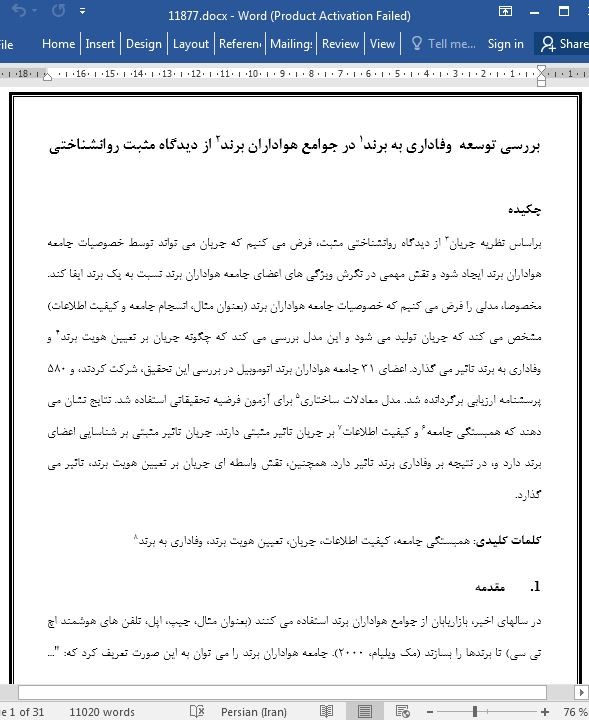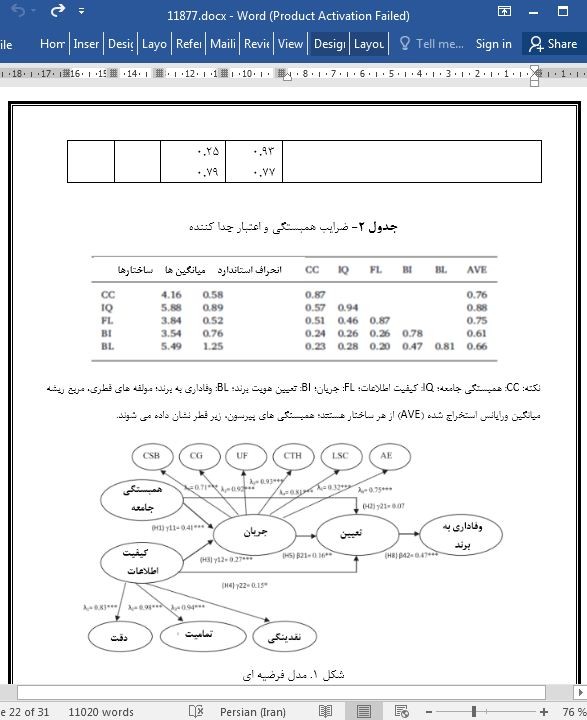
بررسی توسعه وفاداری به برند در جوامع هواداران برند از دیدگاه مثبت روانشناختی
چکیده
براساس نظریه جریان از دیدگاه روانشناختی مثبت، فرض می کنیم که جریان می تواند توسط خصوصیات جامعه هواداران برند ایجاد شود و نقش مهمی در نگرش ویژگی های اعضای جامعه هواداران برند نسبت به یک برند ایفا کند. مخصوصا، مدلی را فرض می کنیم که خصوصیات جامعه هواداران برند (بعنوان مثال، انسجام جامعه و کیفیت اطلاعات) مشخص می کند که جریان تولید می شود و این مدل بررسی می کند که چگونه جریان بر تعیین هویت برند و وفاداری به برند تاثیر می گذارد. اعضای 31 جامعه هواداران برند اتوموبیل در بررسی این تحقیق، شرکت کردند، و 580 پرسشنامه ارزیابی برگردانده شد. مدل معادلات ساختاری برای آزمون فرضیه تحقیقاتی استفاده شد. نتایج نشان می دهند که همبستگی جامعه و کیفیت اطلاعات بر جریان تاثیر مثبتی دارند. جریان تاثیر مثبتی بر شناسایی اعضای برند دارد و، در نتیجه بر وفاداری برند تاثیر دارد. همچنین، نقش واسطه ای جریان بر تعیین هویت برند، تاثیر می گذارد.
1. مقدمه
در سالهای اخیر، بازاریابان از جوامع هواداران برند استفاده می کنند (بعنوان مثال، جیپ، اپل، تلفن های هوشمند اچ تی سی) تا برندها را بسازند (مک ویلیام، 2000). جامعه هواداران برند را می توان به این صورت تعریف کرد که: "... گروهی از مصرف کنندگان با علاقه مشترک به یک برند و هویت اجتماعی توسعه یافته، که اعضای آن به صورت مشترک در اقدامات گروهی شرکت می کنند تا اهداف جمعی را به انجام برسانند و/یا احساسات و تعهدات متقابل را بیان کنند" (باگوزی و دهولاکیا، 2006، صفحه.45). جامعه هواداران برند، مصرف کنندگانی با انواع بخش های اطلاعاتی، مانند محصولات، تجربه کاربری و رقابت بین شرکت ها را ارائه می دهد. همچنین این جامعه برای افزایش وفاداری و تعهد به برند استفاده می شود (مونیز و اًگویین، 2001). در حالی که تحقیقات قبلی، تاثیرات مهم جوامع هواداران برند را بر بازاریابی محصول و کیفیت برند مشخص کردند (لاروچه، حبیبی، ریچارد، و سانکارانارایانان، 2012؛ زاگلیا، 2013)، تعداد اندکی از مدیران، درک می کنند که چگونه به این مزیت ها دست یابند (فورنیر و لی ،2009). موارد زیادی درباره مکانیسم اساسی تاثیر جوامع هواداران برند بر رفتار مصرف کنندگان و برندسازی وجود دارد. بنابراین، تحقیقات ما تلاش می کند تا به این هدف دست یابد.
6. محدودیت ها و تحقیقات آینده
تحقیق ما، تعدادی محدودیت دارد. اول، ما تنها تعدادی انتخابی از خصوصیات جامعه هواداران برند را در نظر گرفتیم. در مطالعات اینده، محققان ممکن است بخواهند تا دیگر خصوصیات احتمالی جامعه هواداران برند را که ممکن است جریان تولید کند، مشخص کنند. بعنوان مثال، شبکه جامعه SAP، که بیش از 2.5 میلیون عضو دارد، مشوق هایی را برای مشارکت در جامعه ارائه می کند. جالب خواهد بود این موضوع بررسی شود که آیا یک سیستم پاداش در جامعه هواداران برند بر جریان و وفاداری به برند تاثیر می گذارد و چگونه تاثیر می گذارد. دوم، ما تخصص و اشتغال اعضا را کنترل نکردیم. علاوه بر این، از آنجا که ما از نمونه گیری گلوله برفی استفاده کردیم، نمونه ها، نشان دهنده هر جامعه هواداران برند نخواهند بود تا مقایسه ای بین جوامع انجام شود. تحقیقات آینده، ممکن است بخواهند برخی از این متغیرها را دستکاری یا کنترل کنند تا مشاهده کنند که چگونه آنها بر تاثیرات مشاهده شده در مطالعه ما تاثیر می گذارند. سوم، این تحقیق به بررسی جامعه هواداران برند اتوموبیل در تایوان پرداخت. بنابراین، نمونه هایی از این جامعه خاص برند در تایوان ممکن است تعمیم پذیری یافته ها را محدود کنند. شرکت ها در صنایع مختلف از محصولات مصرفی (بعنوان مثال، وبسایت Being Girl توسط پروکتر و گمبل) تا نوشیدنی ها (بعنوان مثال، ایده اجرا شده مای استارباکز توسط شرکت قهوه استارباکز) تلاش می کنند تا از اهرم قدرت جوامع هواداران برند استفاده کنند. تحقیقات آینده باید استحکام مدل پیشنهادی را در سراسر جوامع هواداران برند در صنایع مختلف، بررسی کنند.
Abstract
Based on the flow theory from positive psychology, we propose that flow could be generated by brand community characteristics and plays an important role in influencing brand community members' attitudes toward a brand. Specifically, we propose a model that identifies brand community characteristics (i.e., community cohesiveness and information quality) that produce flow and explore how flow impacts brand identification and brand loyalty. Members from 31 automobile brand communities participated in this survey study, and 580 validated questionnaires were returned. Structural Equation Model was used to test the research hypotheses. The results show that community cohesiveness and information quality positively influence flow. Flow positively influences members' brand identification and, subsequently, impacts brand loyalty. The mediating role of flow in building brand identification is also demonstrated.
1. Introduction
In recent years, marketers have been using brand communities (e.g., Jeep, Apple, HTC smartphones) to build brands (McWilliam, 2000). A brand community can be defined as a “…group of consumers with a shared enthusiasm for the brand and a well-developed social identity, whose members engage jointly in group actions to accomplish collective goals and/or express mutual sentiments and commitments” (Bagozzi and Dholakia, 2006, p. 45). It provides consumers with a variety of information pieces, such as products, user experience and competition between companies. It can also be used to enhance brand loyalty and commitment (Muniz & O'Guinn, 2001). While prior research identified the important impact brand communities have on product marketing and brand equity (Laroche, Habibi, Richard, & Sankaranarayanan, 2012; Zaglia, 2013), few managers understand how to achieve these benefits (Fournier & Lee, 2009). There is much left to explore about the mechanism underlying the influence of brand communities on consumer behavior and branding. Therefore, our research attempts to achieve this end.
6. Limitations and future research
Our research has some limitations. First, we only considered a select number of brand community characteristics. In future studies, researchers may want to identify other possible brand community characteristics that might also produce flow. For example, the SAP Community Network, which has over 2.5 million members, provides incentives to community contributions. It would be interesting to examine whether and how a reward system in the brand community influences flow and brand loyalty. Second, we did not control for members' involvement and expertise. Moreover, because we adopted snowball sampling, the samples would not be representative of each brand community in order to perform any comparisons between the communities. Future research may want to control for or manipulate some of these variables in order to see how they influence the observed effects in our study. Third, this research investigated automobile brand communities in Taiwan. Thus, the samples from this specific brand community in Taiwan may limit the generalizability of the findings. Companies in various industries from consumer products (e.g., Being Girl operated by Procter & Gamble) to beverages (e.g., My Starbucks Idea run by Starbucks) attempt to leverage of power of brand communities. Future research should examine the robustness of the proposed model across brand communities in different industries.
چکیده
1. مقدمه
2. چارچوب تحقیقاتی و سابقه نظری
2.1. جریان
2.2. جامعه هواداران برند
2.3. ویژگی های جامعه هواداران برند
2.4. تعیین هویت برند
3. فرضیه های تحقیق
3.1. تاثیر CC و IQ بر جریان و تعیین هویت برند: نقش واسطه ای جریان
3.2. تاثیر تعیین هویت برند بر وفاداری به برند
4. روش شناسی
4.1. نمونه، توسعه تحقیق، و جمع آوری داده
4.2. معیارها
4.3. نتایج
5. مباحث و پیامد های مدیریتی
6. محدودیت ها و تحقیقات آینده
منابع
Abstract
1. Introduction
2. Research framework and theoretical background
2.1. Flow
2.2. Brand community
2.3. Brand community characteristics
2.4. Brand identification
3. Research hypotheses
3.1. Effects of CC and IQ on flow and brand identification: the mediating role of flow
3.2. Effect of brand identification on brand loyalty
4. Methodology
4.1. Sample, survey development, and data collection
4.2. Measures
4.3. Results
5. Discussion and managerial implications
6. Limitations and future research
References
- اصل مقاله انگلیسی با فرمت ورد (word) با قابلیت ویرایش
- ترجمه فارسی مقاله با فرمت ورد (word) با قابلیت ویرایش، بدون آرم سایت ای ترجمه
- ترجمه فارسی مقاله با فرمت pdf، بدون آرم سایت ای ترجمه



